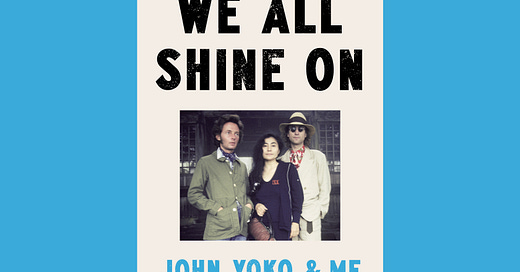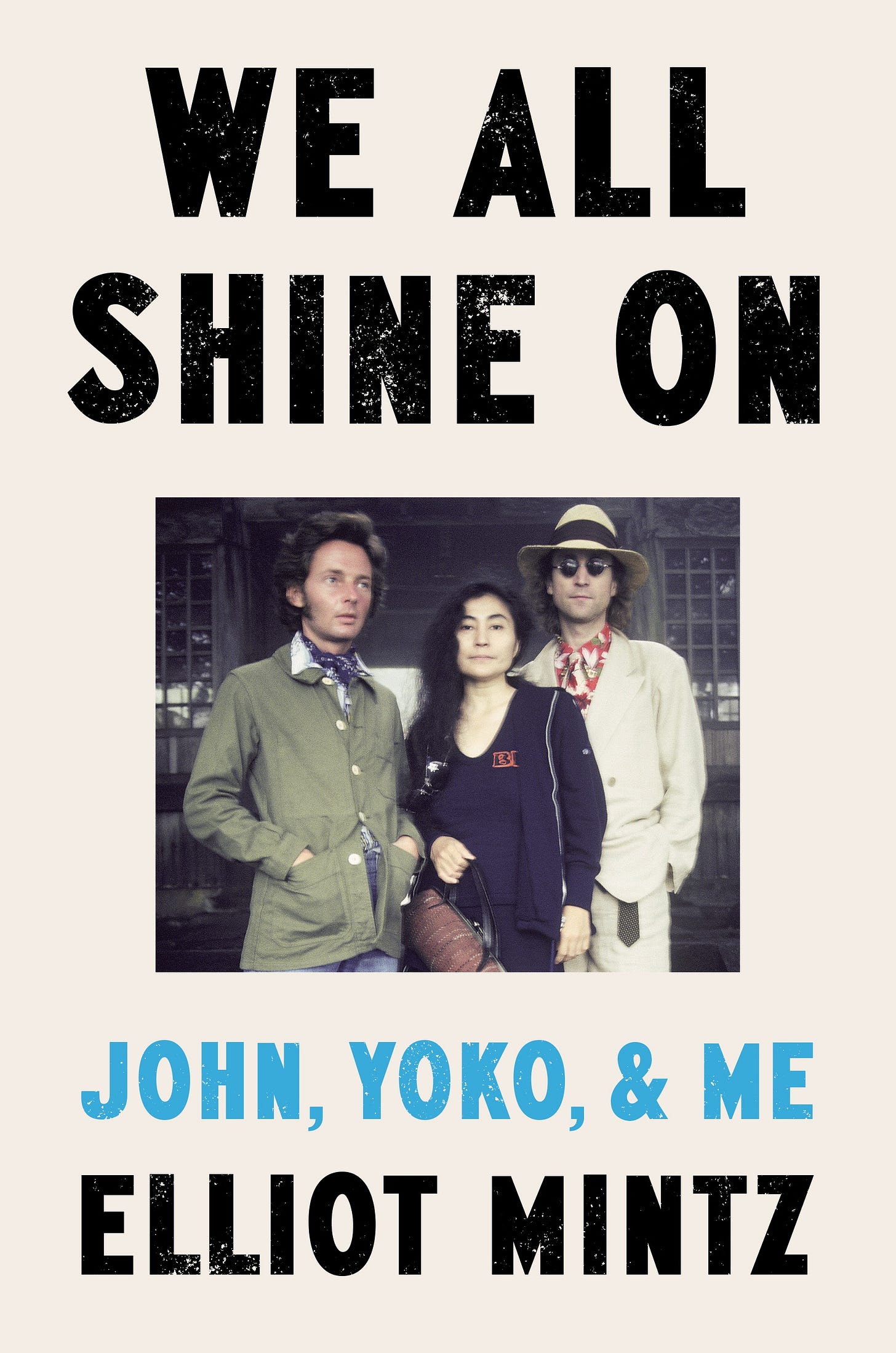Book Review – 'We All Shine On: John, Yoko & Me'
Elliot Mintz offers a behind-the-scenes look at the complexities of the Lennon's relationship and the profound impact they had on each other and the world.
As the author of We All Shine On: John, Yoko & Me, Elliot Mintz unexpectedly lays bare in a gut-wrenching introduction, the February 1981 inventory of John Lennon’s decades-in-the-making personal items, while staying at the Dakota in New York City helping Yoko Ono through her devastating loss. Coupled with their haunting exchange later that evening, the opening will upend whatever expectations are brought into this narrative.
Noted to a new generation as the official spokesperson for the Lennon estate, Mintz has shown grace and restraint in his representation of the legacy during the last four-plus decades. While those old-school observations might not bowl over the unaffected cynics who perpetually keyboard smash all over social media, it unequivocally remains that Mintz was the go-to person for the Lennons before, during, and after every life-altering, pre-Internet scrutinized event.
He moved from New York to Los Angeles to attend L.A. City College and, after several radio positions in the area, landed at KLOS in the autumn of 1971. At home in Laurel Canyon, plucking through his stacks of promotional LPs, he found a disc that turned his world upside down. After listening to Ono’s Fly, he knew two things: “First, I wanted to play the record on the radio. And second, I wanted to speak to the person who made it.”
That interview was Mintz’s cerebral portal into the enigmatic, creative mind of a misunderstood artist. He was hooked. So comfortable were the dozens of exchanges conducted through back-and-forth phone calls, Ono insisted that Mintz talk with her husband on October 9, his 31st birthday, live on the radio.
This hybrid welcome into the eclectic world of the Lennons soon turned out to be the norm. Mintz finally came face-to-face with the couple in June 1972 after an eighty-mile trip to Ojai, California, pondering a confusing set of instructions about why he was headed there. He soon found out the clandestine reasoning: the couple believed they were under surveillance by the FBI, an observation that was not far off base. Included on this excursion was a present he was gifted: an acetate of the soon-to-be controversial Sometime in New York City. However, after making the exclusive announcement and a full airing on his radio show, he was promptly fired. This, and the nickname “Ellie” bestowed upon him by the former Beatle, was his ceremonial entrance into the circus of glorified uncertainty that was John Lennon and Yoko Ono.
Mintz accepted a talk-radio position which kept him busy but he soon discovered he needed a special phone line installed at home to answer calls from Lennon and Ono at any given moment. Whether it was a cantankerous exchange with Lennon on the merits of Dylan or Ono’s deep interest in numerology and her investments in spiritual advisors, it was Mintz she particularly relied upon for what he called “dumpster diving” requests on research for future acquaintances.
Lennon, Ono and Mintz in Japan, 1977. © Nishi F. Saimaru, courtesy of Ms. Saimaru and the author.
By 1973, the Lennons had made the Dakota on West 72nd and Central Park their new home, albeit on several floors and several apartments and Mintz had to his “horror” become an entertainment correspondent for KABC-TV, not entirely comfortable getting his face on television. Yet when he made his maiden visit to the couple’s new digs, he was impressed and knowing the stress they were enduring – a possible deportation for Lennon on top of his less than discreet sexual encounter at a party that humiliated Ono – might be smoothed over with this move. Yet as Mintz spells out, “My guess is that she precisely and carefully orchestrated John’s eviction from the Dakota.”
As for the infamous “Lost Weekend” in L.A., it was Mintz who was in constant contact with Ono back in NYC, looking out for Lennon and as he told her, not there to take sides. He did his best in spite of the copious amounts of alcohol and drugs that were passed around in Lennon’s circle of ‘friends.’ By chance (or fate) Mintz walked into the firestorm known as Phil Spector (recounted by way of an ominous backstory) during the recording sessions for Rock ‘N’ Roll. Describing one distressing episode where a drug and drink-fueled Lennon hurled an insult at him and later called with a not-too-convincing apology, Mintz nearly ended his relationship with the volatile musician over the phone.
The relationship took a while to heal and that paralleled Lennon’s with Paul McCartney. “When we sang together,” Lennon told Mintz in one of their conversations, “Paul and I would share the same microphone. I’d be close enough to kiss him. Back then, I didn’t wear me specs onstage – Brian Epstein said they made me look old. So we’d be playing these concerts, in front of thousands of people, but the only thing I could see was Paul’s face. He was always there next to me – I could always feel his presence. It’s what I remember most about those concerts.”
In due course, as confirmed by Mintz, McCartney did visit Lennon about reconciliation with Ono, making it clear he’d have to sober up and woo her back if he wanted to return home. Mintz touches down discreetly about his impression of companion May Pang and gives her credit for being there to handle Lennon’s difficulties, while reuniting him with his son Julian. He offers personal evidence about the circumstances of the Lennons’ reunion, but was eventually instructed by phone to tell the media, “The separation did not work.”
❧
After the birth of Sean in 1975, he notes that Lennon seemed to have “found himself.” He remained committed to their well-being, and they him during his grief-stricken state over the murder of his close friend Sal Mineo. He trekked off to Japan in August 1977 at their invitation and memorably stayed with the family, through some magically blissful and harrowing times, with the latter usually courteous of Lennon.
Anecdotes galore are told with precious insight: dinner with the McCartneys, holiday shopping at FAO Schwartz and the presents afterward, and most memorably, a 1979 New Year’s Eve get-together that is laced with sad poignancy.
“To Eliot, loaves & fishes” © Nishi F. Saimaru, courtesy of Ms. Saimaru and the author.
The grim realities surrounding December 8, 1980 and its aftermath are heartbreaking, with moments in time that recount anger, despair and concern. Once trusted staffers are shown up as leeches and backstabbers, according to Mintz. He also minces no words in his condemnation of assistant Fred Seaman and author Albert Goldman. It seemed there was no end to Ono’s trials concerning how Lennon’s legacy was to be portrayed. But Mintz stayed the course for both Ono and Sean.
❧
Mintz has been fortunate to witness up close all that came after that tragic year – and more. His touching observations at the premiere for Peter Jackson’s Get Back – attending with Sean and his girlfriend Charlotte Kemp Muhl – found him filled with emotional highs and lows. “Would I have done anything differently? At the time, I couldn't possibly have predicted that John would be snatched away when he was 40; I fully expected that the three of us would grow old together. In retrospect, I was just fortunate to have shared nine years with these two extraordinary beings.”
We All Shine On: John, Yoko & Me by Elliot Mintz is available from Dutton, Amazon in the US and UK, Bookshop.org and numerous retail outlets.








Another review that has convinced me that I must read the book!
I just finished the book by Kenneth Womack about Mal Evans and it's good to see these books countering all the bad press about Yoko Ono. If she hadn't swooped in to save all the Mal Evans archives, no knowing what would have happened to them.
Excellent overview of a remarkable life lived close to the volcano.